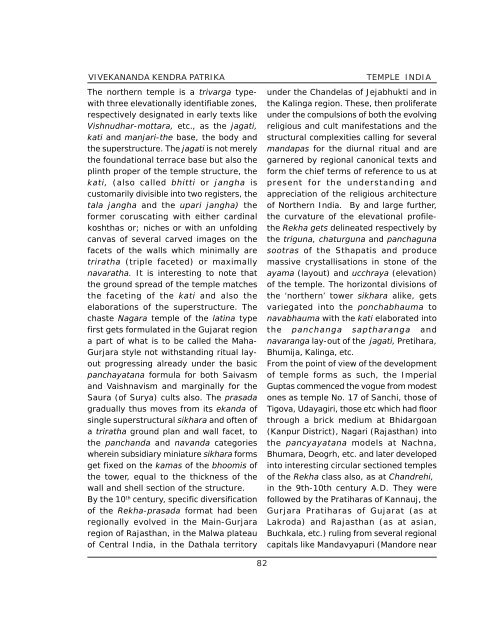Temples In India-1.pdf - Vivekananda Kendra Prakashan
Temples In India-1.pdf - Vivekananda Kendra Prakashan
Temples In India-1.pdf - Vivekananda Kendra Prakashan
Create successful ePaper yourself
Turn your PDF publications into a flip-book with our unique Google optimized e-Paper software.
VIVEKANANDA KENDRA PATRIKAThe northern temple is a trivarga typewiththree elevationally identifiable zones,respectively designated in early texts likeVishnudhar-mottara, etc., as the jagati,kati and manjari-the base, the body andthe superstructure. The jagati is not merelythe foundational terrace base but also theplinth proper of the temple structure, thekati, (also called bhitti or jangha iscustomarily divisible into two registers, thetala jangha and the upari jangha) theformer coruscating with either cardinalkoshthas or; niches or with an unfoldingcanvas of several carved images on thefacets of the walls which minimally aretriratha (triple faceted) or maximallynavaratha. It is interesting to note thatthe ground spread of the temple matchesthe faceting of the kati and also theelaborations of the superstructure. Thechaste Nagara temple of the latina typefirst gets formulated in the Gujarat regiona part of what is to be called the Maha-Gurjara style not withstanding ritual layoutprogressing already under the basicpanchayatana formula for both Saivasmand Vaishnavism and marginally for theSaura (of Surya) cults also. The prasadagradually thus moves from its ekanda ofsingle superstructural sikhara and often ofa triratha ground plan and wall facet, tothe panchanda and navanda categorieswherein subsidiary miniature sikhara formsget fixed on the kamas of the bhoomis ofthe tower, equal to the thickness of thewall and shell section of the structure.By the 10 th century, specific diversificationof the Rekha-prasada format had beenregionally evolved in the Main-Gurjararegion of Rajasthan, in the Malwa plateauof Central <strong>In</strong>dia, in the Dathala territoryTEMPLE INDIAunder the Chandelas of Jejabhukti and inthe Kalinga region. These, then proliferateunder the compulsions of both the evolvingreligious and cult manifestations and thestructural complexities calling for severalmandapas for the diurnal ritual and aregarnered by regional canonical texts andform the chief terms of reference to us atpresent for the understanding andappreciation of the religious architectureof Northern <strong>In</strong>dia. By and large further,the curvature of the elevational profiletheRekha gets delineated respectively bythe triguna, chaturguna and panchagunasootras of the Sthapatis and producemassive crystallisations in stone of theayama (layout) and ucchraya (elevation)of the temple. The horizontal divisions ofthe ‘northern’ tower sikhara alike, getsvariegated into the ponchabhauma tonavabhauma with the kati elaborated intothe panchanga saptharanga andnavaranga lay-out of the jagati, Pretihara,Bhumija, Kalinga, etc.From the point of view of the developmentof temple forms as such, the ImperialGuptas commenced the vogue from modestones as temple No. 17 of Sanchi, those ofTigova, Udayagiri, those etc which had floorthrough a brick medium at Bhidargoan(Kanpur District), Nagari (Rajasthan) intothe pancyayatana models at Nachna,Bhumara, Deogrh, etc. and later developedinto interesting circular sectioned templesof the Rekha class also, as at Chandrehi,in the 9th-10th century A.D. They werefollowed by the Pratiharas of Kannauj, theGurjara Pratiharas of Gujarat (as atLakroda) and Rajasthan (as at asian,Buchkala, etc.) ruling from several regionalcapitals like Mandavyapuri (Mandore near82
















